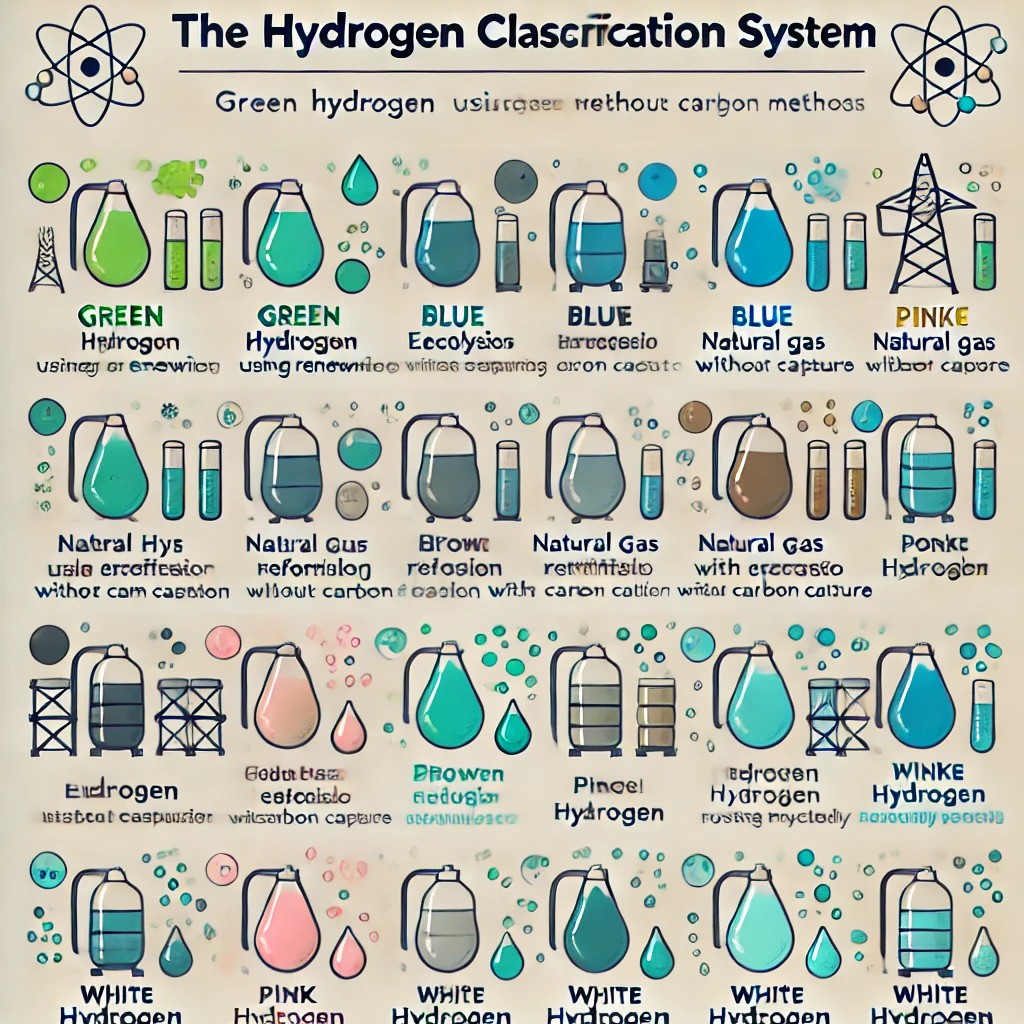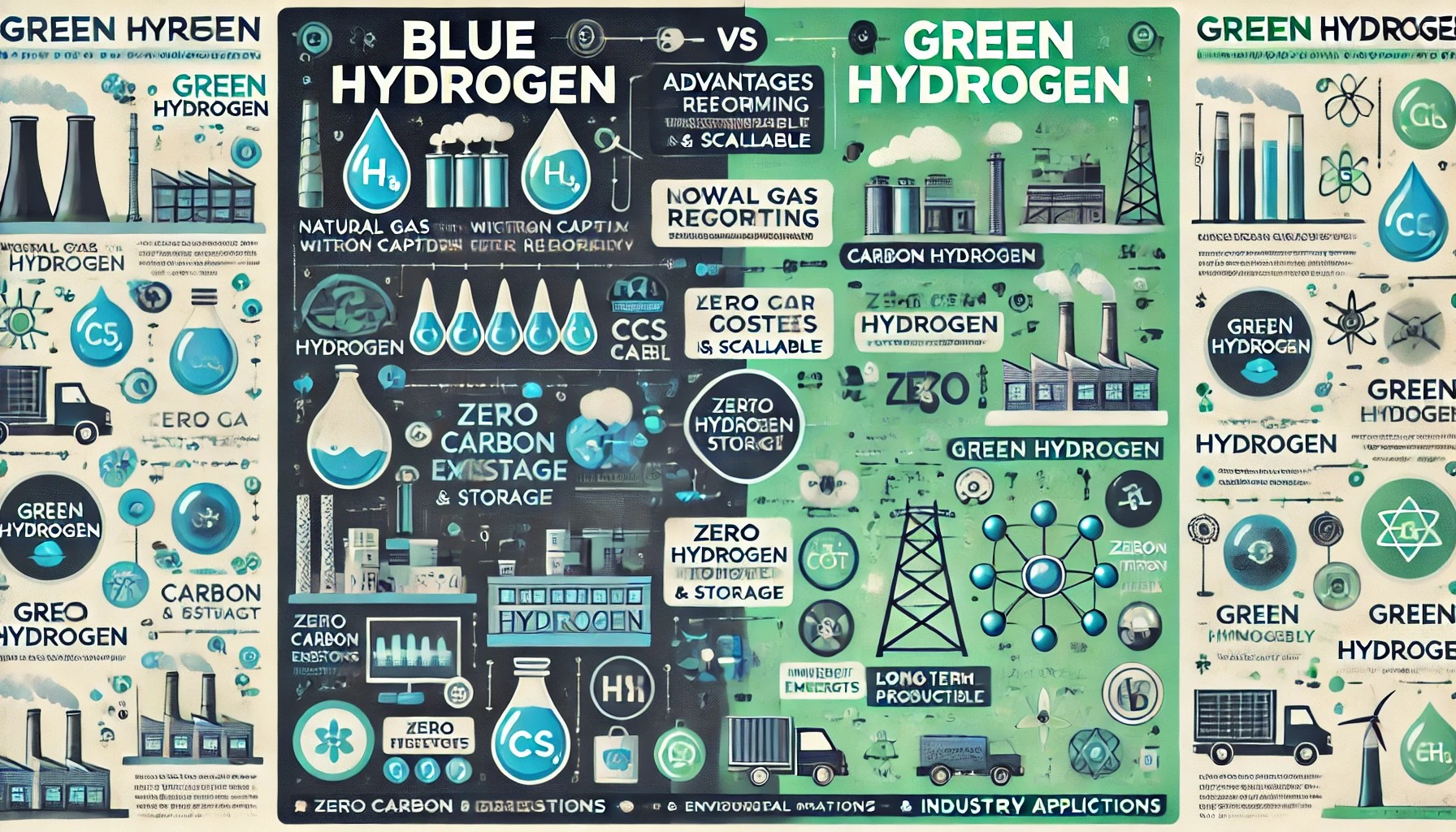Imagine a world where clean, limitless energy powers our industries, fuels our cars, and heats our homes—all while leaving behind little to no carbon footprint. Hydrogen, the universe’s most abundant element, is at the center of this vision. But not all hydrogen is created equal.
As the global push for sustainable energy intensifies, hydrogen is emerging as a game-changer. From green hydrogen produced through renewable energy to blue hydrogen that utilizes carbon capture, each type has its own production method, environmental impact, and industrial applications. Understanding these distinctions is crucial for businesses, policymakers, and anyone interested in the future of clean energy.
This comprehensive guide will break down the different types of hydrogen, their production processes, and their real-world applications. Whether you’re an energy professional or simply curious about the hydrogen revolution, this article will equip you with the knowledge to navigate this rapidly evolving landscape. Let’s dive in.
Understanding Hydrogen Classification
Hydrogen is often classified using a color-coded system that helps differentiate its production methods and environmental impact. This classification is essential because the sustainability of hydrogen as an energy source depends largely on how it is produced. The primary types include green, blue, gray, brown/black, pink, turquoise, and white hydrogen—each with varying levels of carbon emissions and energy efficiency.
As the world transitions toward cleaner energy solutions, hydrogen plays a vital role in reducing reliance on fossil fuels. It offers a versatile and efficient energy carrier that can be used across multiple industries, from transportation to industrial manufacturing. However, not all hydrogen contributes equally to this transition. Green hydrogen, for example, is seen as the ultimate clean energy source, whereas gray and brown hydrogen still rely on fossil fuels and produce significant emissions. By understanding these distinctions, industries and policymakers can make informed decisions to accelerate the adoption of low-carbon hydrogen solutions.
Types of Hydrogen
Green Hydrogen
Green hydrogen is considered the gold standard of clean energy. It is produced through electrolysis, a process that splits water (H₂O) into hydrogen (H₂) and oxygen (O₂) using electricity generated from renewable sources like wind, solar, or hydropower. Because no carbon emissions are produced during this process, green hydrogen is entirely sustainable.
The main advantage of green hydrogen is its potential to decarbonize multiple sectors, including heavy industries and transportation. It is used in fuel cells to power vehicles, in industrial processes like steelmaking, and as an energy storage solution for balancing electricity grids. However, the current challenge lies in its high production costs and the need for large-scale renewable energy infrastructure.
Blue Hydrogen
Blue hydrogen is produced using natural gas reforming, where methane (CH₄) is converted into hydrogen and carbon dioxide (CO₂). Unlike gray hydrogen, blue hydrogen incorporates carbon capture and storage (CCS) technology to trap and store the CO₂ emissions, reducing its overall environmental impact.
Although blue hydrogen is not entirely emission-free, it serves as a transitional solution for industries looking to lower their carbon footprint while renewable energy capacities scale up. It is commonly used for energy storage, industrial applications, and as a cleaner alternative to traditional fossil fuels in power generation.
Gray Hydrogen
Gray hydrogen is currently the most common form of hydrogen, accounting for a significant portion of global production. It is generated through natural gas reforming but without carbon capture, meaning that CO₂ emissions are released into the atmosphere. This process contributes to climate change, making gray hydrogen a less sustainable option.
Despite its environmental drawbacks, gray hydrogen remains widely used in industries such as petroleum refining, ammonia production, and chemical manufacturing. However, with growing pressure to reduce emissions, industries are increasingly looking toward greener alternatives.
Brown/Black Hydrogen
Brown and black hydrogen are produced through coal gasification, a process that converts coal into hydrogen and carbon dioxide. Due to the high carbon emissions associated with this method, it is considered the most polluting form of hydrogen.
As the world moves toward cleaner energy sources, the future of brown and black hydrogen is uncertain. Many countries are phasing out coal-based hydrogen production in favor of greener alternatives, though some regions with abundant coal resources still rely on it.
Pink Hydrogen
Pink hydrogen is produced through electrolysis powered by nuclear energy. While nuclear power does not generate carbon emissions, it does raise concerns related to radioactive waste and public perception. However, pink hydrogen could play a significant role in clean hydrogen production, especially in countries with established nuclear infrastructure.
Industries looking for a reliable and low-carbon hydrogen source may turn to pink hydrogen for applications in energy storage, industrial processes, and transportation.
Turquoise Hydrogen
Turquoise hydrogen is an emerging type that is produced through methane pyrolysis, a process that splits methane into hydrogen and solid carbon instead of CO₂. This method has the potential to significantly reduce emissions while producing valuable solid carbon byproducts.
While still in its early stages, turquoise hydrogen presents a promising alternative to blue and gray hydrogen. If scaled effectively, it could provide a lower-emission solution for industries that currently rely on fossil fuel-based hydrogen.
White Hydrogen
White hydrogen refers to naturally occurring hydrogen deposits found underground. Unlike other types, it does not require industrial production. Although research on white hydrogen extraction is still in its infancy, it presents an exciting opportunity for a naturally occurring, emission-free hydrogen source.
If viable extraction methods are developed, white hydrogen could provide a low-cost, environmentally friendly alternative to manufactured hydrogen.
Applications of Hydrogen Across Industries
Hydrogen’s versatility makes it an essential energy source across various sectors:
- Energy Sector: Hydrogen fuel cells and power generation help stabilize electricity grids and provide clean backup power.
- Transportation: Hydrogen-powered vehicles, trains, ships, and even aircraft are being developed as alternatives to fossil fuel-powered transportation.
- Industrial Use: Hydrogen is crucial in steel production, ammonia synthesis, and refining processes, offering a cleaner alternative to traditional methods.
- Residential & Commercial Use: Hydrogen can be used for heating and electricity generation in buildings, reducing dependence on natural gas.
- Hydrogen as an Energy Carrier: Hydrogen plays a crucial role in energy storage, helping balance supply and demand for renewable energy sources like wind and solar.
Challenges and Future of Hydrogen
Despite its potential, hydrogen faces several challenges that must be addressed for widespread adoption:
- Cost and Infrastructure: Green hydrogen production remains expensive, and the infrastructure for transportation, storage, and distribution is still underdeveloped.
- Policy Support and Investments: Governments and private investors must accelerate funding for hydrogen projects, including subsidies and incentives for cleaner production methods.
- Technological Advancements: Ongoing research into more efficient electrolysis, carbon capture, and alternative production methods will help drive costs down and improve scalability.
As advancements continue, hydrogen is set to play a crucial role in the global energy transition, providing a cleaner, more sustainable alternative to fossil fuels.
Conclusion
Hydrogen is a powerful energy source with diverse applications, but its sustainability depends on how it is produced. Green and blue hydrogen are leading the way toward a cleaner future, while gray and brown hydrogen remain widely used but environmentally harmful. Emerging types like turquoise and white hydrogen present exciting possibilities for the future.
As industries and governments push for cleaner energy solutions, hydrogen will undoubtedly be a key player in the transition to a low-carbon economy. The question is no longer whether hydrogen will be part of the future—it’s how quickly we can make it a dominant force in global energy.
Frequently Asked Questions (FAQs)
1. What is the most environmentally friendly type of hydrogen?
Green hydrogen is the most environmentally friendly type because it is produced using renewable energy sources and does not generate carbon emissions during production.
2. Why is hydrogen classified by colors?
The color classification system helps distinguish different hydrogen production methods based on their environmental impact and energy sources.
3. Is blue hydrogen a clean energy source?
Blue hydrogen is cleaner than gray hydrogen because it uses carbon capture and storage (CCS) to reduce emissions, but it is not entirely emission-free.
4. What is the biggest challenge in scaling up hydrogen production?
The main challenges include high production costs, infrastructure limitations for transportation and storage, and the need for policy support and investments.
5. Can hydrogen replace fossil fuels completely?
Hydrogen has the potential to replace fossil fuels in many sectors, including transportation and industry, but it requires significant advancements in production, storage, and distribution technologies.
6. How is hydrogen stored and transported?
Hydrogen can be stored as a gas under high pressure, as a liquid at extremely low temperatures, or in chemical carriers like ammonia or liquid organic hydrogen carriers (LOHCs) for easier transport.
7. What industries benefit the most from hydrogen?
Industries such as steel manufacturing, transportation (fuel cell vehicles, aviation, shipping), power generation, and chemical production (ammonia, refining) benefit significantly from hydrogen use.
8. Is white hydrogen a viable alternative to produced hydrogen?
White hydrogen, which occurs naturally underground, is still in the research phase. If viable extraction methods are developed, it could become a game-changer for clean hydrogen production.
9. How does hydrogen compare to battery storage for renewable energy?
Hydrogen is better suited for long-term energy storage and industrial applications, while batteries are more efficient for short-term storage and consumer electronics.
10. What is the future of hydrogen in the global energy transition?
With increasing investments and technological advancements, hydrogen is expected to play a key role in decarbonizing industries, supporting renewable energy storage, and transforming transportation in the coming decades.


